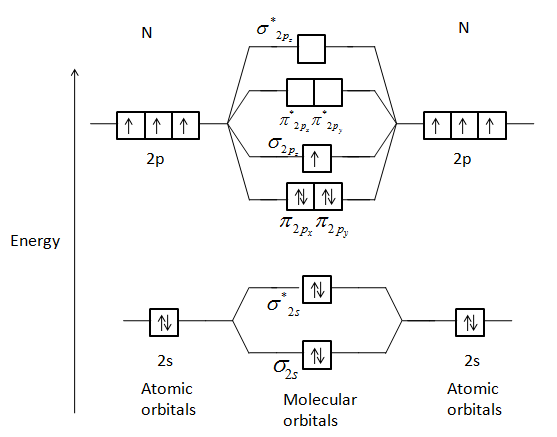
Answer
377.4k+ views
Hint: We know that generally the molecular orbital diagrams are used to understand the bonding of a diatomic molecule. You should know that molecular orbital diagrams are used to deduce magnetic properties of a molecule; they also help us to find out the bond order of the molecule.
Complete Step By Step Solution :
First, let us understand the concept of molecular orbital theory. On a very general basis, electrons are not assigned to individual bonds between atoms, but they move under the influence of the nuclei in the whole molecule. Molecular orbital theory is a method for describing the electronic structure of the molecule.
As we know the electron has an electron magnetic dipole moment, which is generally generated by the electron’s spin property, which induces an electric charge into motion. As we can see the term “magnetic” refers to the magnetic dipole. There are many types of magnetic behavior which are paramagnetic, diamagnetic and ferromagnetic. Bond order: In simple words, it can be stated that bond order is the difference between the number of bonds and antibonds. Bond number also gives an indication of the stability of a bond.

When two atomic orbitals combine they form two new molecular orbitals, one by the additive effect of the atomic orbitals which is called the bonding molecular orbital and the other is formed by the subtractive effect of the atomic orbitals which is called the antibonding molecular orbital.
Note:
Remember that you should generally know that the electron probability distribution around a nucleus in an atom is given by an atomic orbital; likewise the electron probability distribution around a group of nuclei in a molecule is given by a molecular orbital diagram.
Complete Step By Step Solution :
First, let us understand the concept of molecular orbital theory. On a very general basis, electrons are not assigned to individual bonds between atoms, but they move under the influence of the nuclei in the whole molecule. Molecular orbital theory is a method for describing the electronic structure of the molecule.
As we know the electron has an electron magnetic dipole moment, which is generally generated by the electron’s spin property, which induces an electric charge into motion. As we can see the term “magnetic” refers to the magnetic dipole. There are many types of magnetic behavior which are paramagnetic, diamagnetic and ferromagnetic. Bond order: In simple words, it can be stated that bond order is the difference between the number of bonds and antibonds. Bond number also gives an indication of the stability of a bond.

When two atomic orbitals combine they form two new molecular orbitals, one by the additive effect of the atomic orbitals which is called the bonding molecular orbital and the other is formed by the subtractive effect of the atomic orbitals which is called the antibonding molecular orbital.
Note:
Remember that you should generally know that the electron probability distribution around a nucleus in an atom is given by an atomic orbital; likewise the electron probability distribution around a group of nuclei in a molecule is given by a molecular orbital diagram.
Recently Updated Pages
Who among the following was the religious guru of class 7 social science CBSE

what is the correct chronological order of the following class 10 social science CBSE

Which of the following was not the actual cause for class 10 social science CBSE

Which of the following statements is not correct A class 10 social science CBSE

Which of the following leaders was not present in the class 10 social science CBSE

Garampani Sanctuary is located at A Diphu Assam B Gangtok class 10 social science CBSE

Trending doubts
A rainbow has circular shape because A The earth is class 11 physics CBSE

Which are the Top 10 Largest Countries of the World?

Fill the blanks with the suitable prepositions 1 The class 9 english CBSE

Which of the following was the capital of the Surasena class 6 social science CBSE

How do you graph the function fx 4x class 9 maths CBSE

The Equation xxx + 2 is Satisfied when x is Equal to Class 10 Maths

Give 10 examples for herbs , shrubs , climbers , creepers

Difference between Prokaryotic cell and Eukaryotic class 11 biology CBSE

Who was the first Director General of the Archaeological class 10 social science CBSE




